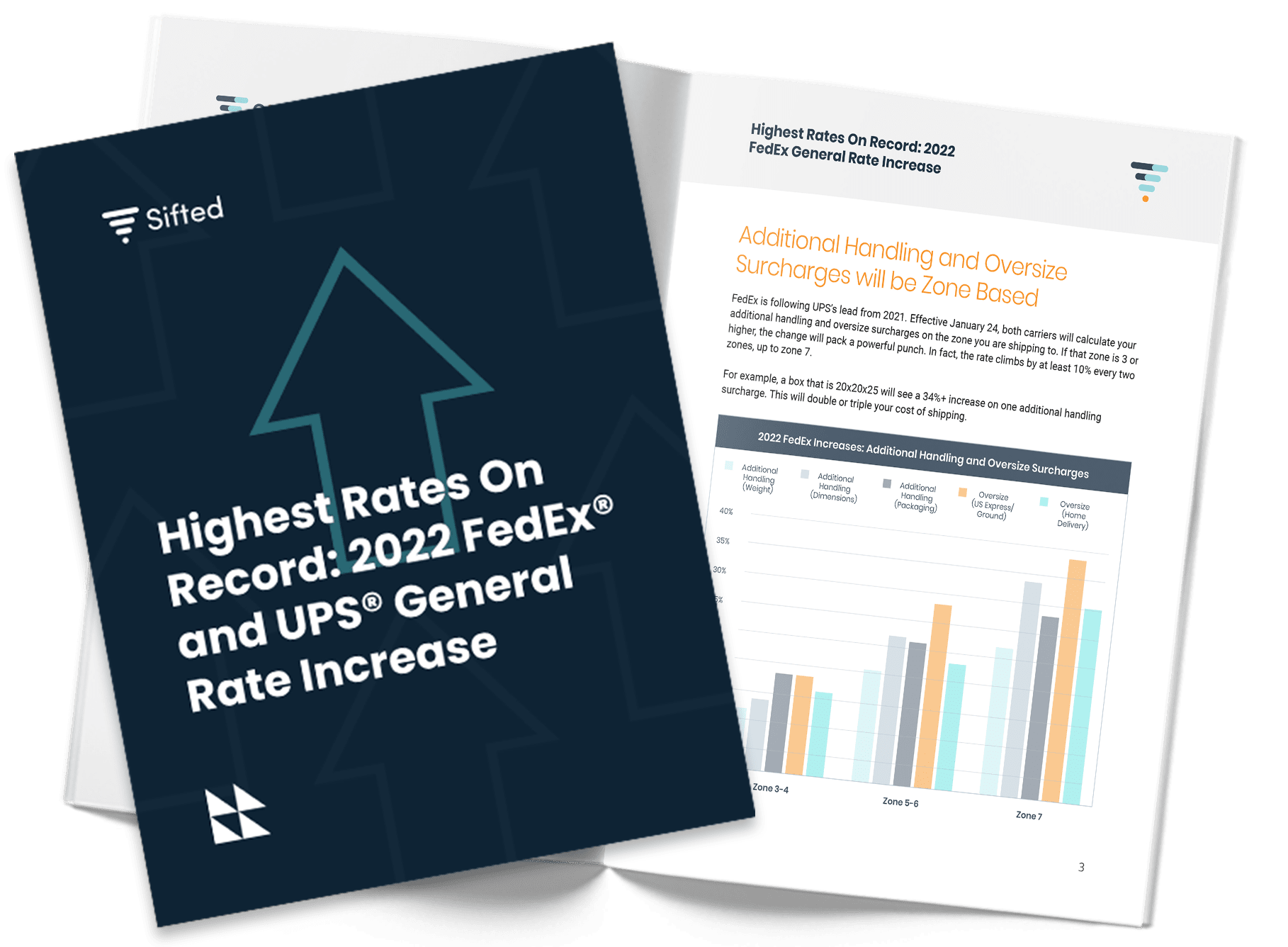Mastering the Art of Parcel Contract Negotiation
Shipping is an integral part of your business, and it’s only getting more expensive and complicated. Rate increases, overcharges, missed pickups, and late deliveries—they all affect your bottom line. And with added pressure to reduce costs, poorly executed shipping contracts and pricing agreements can cause further unnecessary overspending.
Whether you run a large, small, or medium-sized business, becoming better at parcel contract negotiation boosts your ability to optimize shipping costs, offset rate increases, and better fulfill the unique demands of your supply chain.
In this article, we’ll review best practices for shipping contract negotiations, so you get lower shipping rates from your carrier.
Sifted Logistics Intelligence empowers shippers through various cost optimizations, including contract optimization.
Understanding UPS
UPS contracts usually have separate sections for specific pricing items, including accessorial fees, refunds, surcharges, and incentives. UPS issues a wholesale proposal of new rates based on the shipper’s volume every time a new shipping contract replaces an older one. This means price changes at contract renewal will affect all UPS service levels.
The first few pages of a UPS contract include the general information related to UPS customers and the term duration and termination clause.
Under Addendum A of your UPS agreement, you’ll find information about customers’ shipper accounts and commodity tiers.
The commodity tier relates to the UPS Hundredweight Service rate tier level allocated according to the particular package characteristics. Dense products like iron rods get a tier 1 rating (more costly), whereas less dense items such as mattresses get a tier 7 rating (less costly).
Addendum B is most shippers’ point of focus during the contract negotiation process. It includes terms related to portfolio incentives, minimum charges, guaranteed discounts, applicable DIM weight factors, and fee adjustments related to accessorials like additional handling and residential surcharges.
Unlike FedEx, UPS calculates earned discounts based on the weekly average of the preceding year.
Understanding FedEx
FedEx agreements are divided into subsections for FedEx service levels, Ground, and Express. Similarly, there are separate agreements based on the number of shipping options you sign up for (such as international shipping, FTL, and LTL deliveries) and your shipping profile. Make sure that you have all your current carrier agreements at hand before reviewing parcel shipping rates.
The first few pages of FedEx contracts discuss the general terms and agreements (e.g., automation, unexpected volume, confidentiality, etc.) between the carrier and the shippers.
Next, there are separate pricing pages for domestic and international shipping. These pages include information about shipping volume and applicable discounts based on your total shipping spend over the last 52 weeks.
In contrast to UPS, if FedEx proposes a price change in one (or more) service levels, it will not necessarily affect rates of other service levels unless explicitly mentioned.
Other notable agreement terms include minimum transportation charges on domestic shipments and discounts offered on international shipping under domestic pricing or based on shipping volume.
Towards the end of your FedEx agreement, you’ll find terms related to accessorial and dimensional weight concessions, including applicable discounts on FedEx Ground, Express, Air, and other service levels.
Guaranteed Service Refunds (GSR), also known as Money-Back Guarantee (MBG), is another important agreement term related to refunds (or credit to your account) for any late deliveries.
Are shipping mistakes slipping past your glance? Take better charge of your shipping costs to avoid mistakes with Sifted Logistics Intelligence.

Mastering the Art of Parcel Contract Negotiation
When to Plan Parcel Contract Negotiations
Q4 is the perfect time to sift through your shipping data and understand your business needs before any carrier contract negotiation attempt. And if you need some help, Sifted has the analytics expertise to set you on the right path.
Carriers announce the General Rate Increase (GRI) in September/October, giving you the foundation for a January negotiation. It’s a convenient time to do an annual review of the impact new carrier rates will have on your business. Then you can decide if you need to focus on shipping cost optimization through contract negotiation.
Renegotiating your contract is also important if you know the current contract terms don’t align with your business needs. However, you don’t want to be the shipper asking for renegotiations every few months, nor should you wait several years to give your rep a call.
Ideal timings to ask for contract renegotiations from your carrier include:
- A few months before the contract agreement ends
- When significant changes are announced
- Annually
What can you negotiate within your carrier agreement?
Everything about your carrier agreement is negotiable when you know what to ask for. This includes accessorial fees, surcharges, discounts, and freight classification.
Small parcel carriers like FedEx, UPS, and DHL create pricing agreements to ensure they remain profitable in the situation of disruptions, inefficient shipments, and more. For this reason, you will find terms and conditions in the shipping contract related to minimum charges, waivers, DIM weight factors, surcharges, accessorial fees, varying discounts, and incentives.
You can use shipping data analysis and parcel auditing to better understand your shipping pain points (such as incorrect accessorials and confusing carrier incentives) and identify areas where you may be leaving money on the table. This insight keeps your company’s interests top of mind during contract negotiations.
Having a hard time staying on top of potential refunds? Simplify this process with Sifted’s automated parcel audit that keeps track of this for you!
Pricing to Keep in Mind
Now that you have a better understanding of terms and conditions in shipping contracts and best practices to prepare for pricing negotiations, let’s inspect some major cost spends you should consider before sitting at the negotiating table.
General rate increase (GRI)
A General Rate Increase (GRI) is an annual adjustment of shipping fees and surcharges by major shipping carriers. FedEx and UPS increased their fees by an average of 5.9% for 2022 across all their services, up from 4.9% in 2021.
This rate change affects ground, air, and international shipments as well as surcharges including residential delivery surcharge, large package surcharge, and additional handling surcharge. But for example, when your shipping costs for additional handling rise by over 25%, your rates are likely to increase well above the average of 5.9%. You need to know the actual impact GRI will have on you.
Dimensional weight (DIM weight)
Dimensional weight is a pricing technique used by carriers to determine shipping rates based on the space occupied by a package, rather than its actual weight. It’s calculated using a formula that accounts for the dimensional measurements of a package: (L x W x H) / DIM divisor
The standard DIM divisor for FedEx, for example, is 139. Your carrier electronically scans your package to determine its dimensions and calculate the DIM weight, rounding up to the next pound. If the DIM weight of a package is larger than its actual weight, your shipping cost is calculated based on the DIM weight.
Since the shipping price is dependent on the carrier’s DIM divisor, a change in its value can greatly affect a shipper’s bottom line.
Additional handling surcharges
Additional handling charges are an extra fee added to the base shipping rate of a package if it doesn’t conform to the carrier’s set size, weight, and shape limits.
If you’re not careful, these charges can quickly pile up and tank your bottom line. Major shipping carriers strictly enforce additional handling surcharges, however, you can work to reduce these costs during the contract negotiation process.
Service mix
A number of US retailers use FedEx and UPS to get eCommerce orders delivered to their customers’ doorsteps. Both carriers increase their shipping rates annually and charge DIM weight prices that are not feasible for many product types.
But by creating a carrier mix based on the specific requirements of your business and customers, you’ll achieve substantial cost reduction. You can do this by learning about the services that each carrier prioritizes (such as B2B shipments and conveyable freight) and how your service mix can best align with each carrier.
The benefit of a good carrier mix is resiliency—you can avoid service limitations and capacity issues from carriers by having options. When carriers know that you have options, you’ll gain leverage to get better rates or services as well.
Here are a few questions to ask yourself to get a better understanding of your service mix:
- Do you ship internationally or have higher premiums to fulfill your operational requirements?
- Do you pay more for two or three-day deliveries?
- Are your parcels shipped domestically via air or by ground?
- Do you have the correct service type? For example, are there recorded shipments via air, but the carriers actually move them via their ground service?
Weight and zone distribution
Package shipping fees are dependent on the shipping zones and weights. Zone charts were developed for mailers to apply the proper postage rates to a piece of mail. Use a zone chart to create a better understanding of your shipping activities and efficiencies.
Shipping carriers have complete information about a shipper’s distribution, and you can’t afford to come unprepared to the table. To negotiate from a position of strength, you need to have a complete grasp of your shipping volume and how many packages are shipped to each shipping zone, as well as their weight ranges. You need to know your shipping profile as well as your carriers do.
For example, if you ship high-volume orders to an expensive shipping zone, you can use it as leverage to receive greater discounts.
Destination points
Shipping carriers implement delivery area surcharges to compensate for the additional costs associated with last-mile delivery. You may not control where your customer lives, but you can ask for a flat fee when shipping to specific zip codes. This is a big one to remember if you want to keep your costs down.
Keep in mind all of your options. For example, U.S. Postal Service and regional carriers offer great service, have fewer surcharges, and even provide faster delivery in some areas.
Confidently negotiate your carrier contract with Sifted Logistics Intelligence
Shipping carriers are valuable parts of the shipping process and vital to creating viable pricing agreements that benefit both shippers and shipping carriers alike. Shipping data analytics and parcel audits can give you information that can be used to negotiate better rates, reduce transportation spending, and improve your bottom line.
Sifted Logistics Intelligence uses AI to compare your unique shipping profile with potential carriers based on carrier rates, services, and capabilities. This approach gives you the confidence you need to secure better rates in contract negotiations while strengthening your carrier relationships.
Ready to get better carrier rates for your company? Get a free demo from Sifted!











